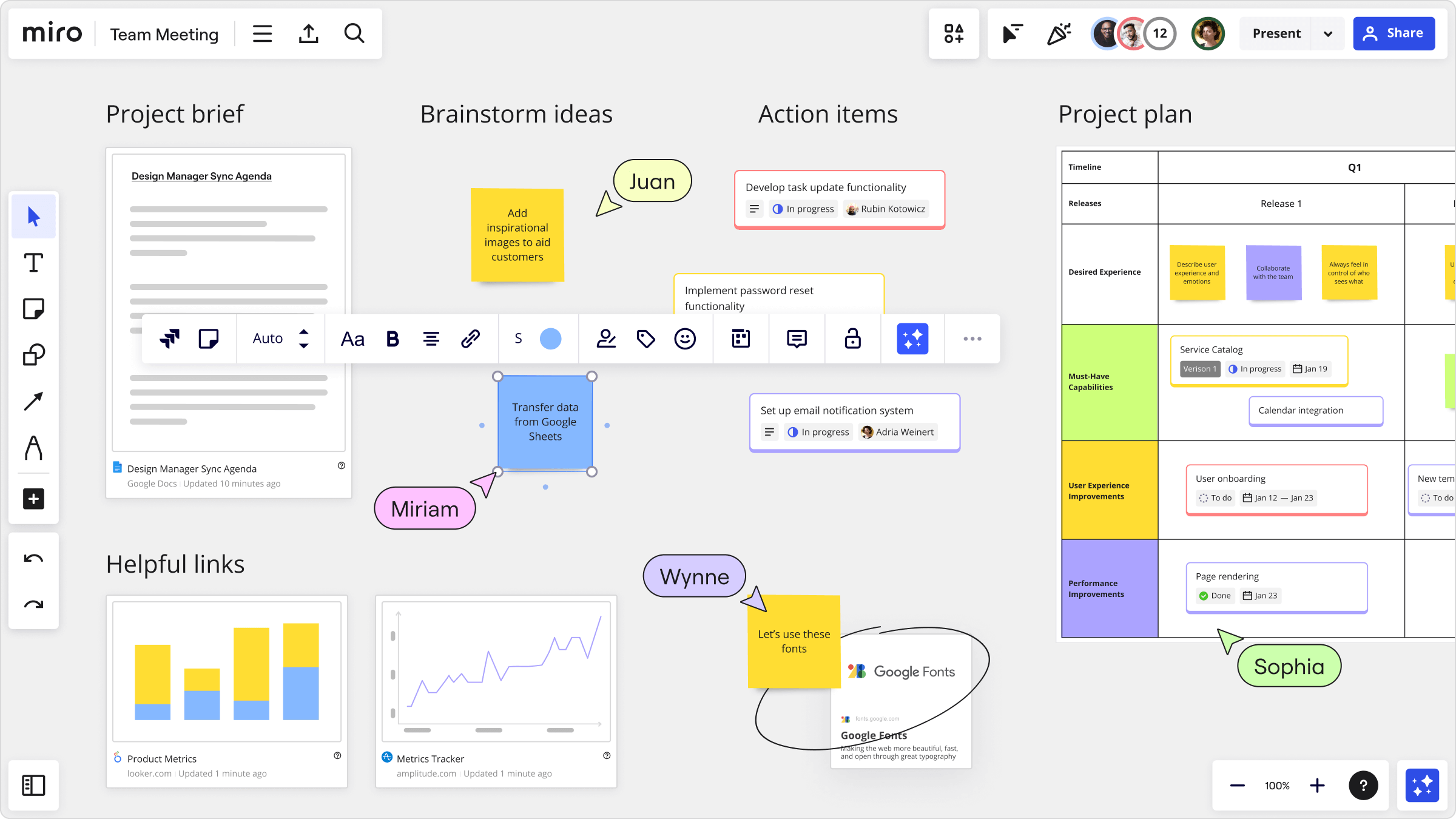Miro: Complete Buyer's Guide
The leading AI-enhanced visual collaboration platform
Miro is the leading AI-enhanced visual collaboration platform transforming how design teams ideate, prototype, and collaborate across distributed organizations.
Market Position & Maturity
Market Standing
Miro occupies the dominant market position in the interactive whiteboard space, operating within a market that has demonstrated consistent growth from USD 4.82 billion in 2024 to projected USD 7.30 billion by 2030 [4][27].
Company Maturity
Miro's comprehensive integration ecosystem of 100+ applications [218][221] represents significant engineering investment and partnership development that smaller competitors cannot match.
Growth Trajectory
Expanding enterprise adoption patterns, with organizations achieving 333% ROI [137][150] driving continued market expansion.
Industry Recognition
The platform's role in Agile development workflows with documented 78% reduction in manual workflow creation [177] has established Miro as essential infrastructure for modern development practices.
Strategic Partnerships
Strategic partnerships include deep integrations with enterprise software ecosystems, particularly Jira synchronization capabilities and Azure DevOps compatibility [163][177].
Longevity Assessment
The platform's comprehensive approach to AI integration, extensive partnership ecosystem, and proven enterprise deployment capabilities create substantial competitive moats.
Proof of Capabilities
Customer Evidence
A human capital management firm achieved transformation of Program Increment planning from 2-day processes to 4-hour sessions through systematic AI integration [137][129].
Quantified Outcomes
Teams utilizing Miro AI report 19% reduction in project completion times through automated diagramming capabilities and enhanced real-time collaboration features [41][42].
Case Study Analysis
Enterprise customer validation demonstrates Miro's effectiveness across diverse implementation scenarios with measurable business outcomes.
Market Validation
Market adoption evidence includes widespread deployment across technology-forward organizations, with educational sector adoption reaching 60% teacher utilization rates [54].
Competitive Wins
Competitive displacement examples demonstrate Miro's ability to win against established alternatives. The platform's comprehensive integration ecosystem of 100+ applications compared to Mural's 40+ apps [218][219] provides clear competitive advantages.
Reference Customers
Reference customer evidence spans multiple industries and use cases, though specific customer names require verification for public disclosure.
AI Technology
Miro's AI technology foundation centers on three core capability areas that deliver measurable productivity improvements for design professionals.
Architecture
Architecture and deployment leverage cloud-native infrastructure with AWS Cloud WAN integration that resolved previous static route limitations causing 3-day VPC deployment delays [133].
Primary Competitors
Mural, Vibe Canvas, Figma, Lucidspark, Adobe Illustrator
Competitive Advantages
Comprehensive workflow integration and enterprise-grade deployment capabilities. Jira synchronization enables 78% reduction in manual workflow creation [177].
Market Positioning
Miro's role as a comprehensive platform competing against both specialized tools and enterprise collaboration suites.
Win/Loss Scenarios
Organizations prioritizing cross-functional collaboration, extensive integration needs, and comprehensive workflow support find Miro's capabilities align well with requirements.
Key Features

Pros & Cons
Use Cases
Integrations
Pricing
Featured In Articles
Comprehensive analysis of AI Whiteboard Illustration for AI Design for AI Design professionals. Expert evaluation of features, pricing, and implementation.
How We Researched This Guide
About This Guide: This comprehensive analysis is based on extensive competitive intelligence and real-world implementation data from leading AI vendors. StayModern updates this guide quarterly to reflect market developments and vendor performance changes.
230+ verified sources per analysis including official documentation, customer reviews, analyst reports, and industry publications.
- • Vendor documentation & whitepapers
- • Customer testimonials & case studies
- • Third-party analyst assessments
- • Industry benchmarking reports
Standardized assessment framework across 8 key dimensions for objective comparison.
- • Technology capabilities & architecture
- • Market position & customer evidence
- • Implementation experience & support
- • Pricing value & competitive position
Research is refreshed every 90 days to capture market changes and new vendor capabilities.
- • New product releases & features
- • Market positioning changes
- • Customer feedback integration
- • Competitive landscape shifts
Every claim is source-linked with direct citations to original materials for verification.
- • Clickable citation links
- • Original source attribution
- • Date stamps for currency
- • Quality score validation
Analysis follows systematic research protocols with consistent evaluation frameworks.
- • Standardized assessment criteria
- • Multi-source verification process
- • Consistent evaluation methodology
- • Quality assurance protocols
Buyer-focused analysis with transparent methodology and factual accuracy commitment.
- • Objective comparative analysis
- • Transparent research methodology
- • Factual accuracy commitment
- • Continuous quality improvement
Quality Commitment: If you find any inaccuracies in our analysis on this page, please contact us at research@staymodern.ai. We're committed to maintaining the highest standards of research integrity and will investigate and correct any issues promptly.